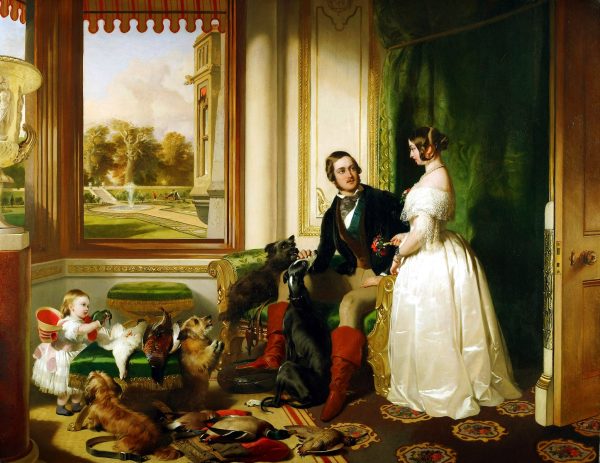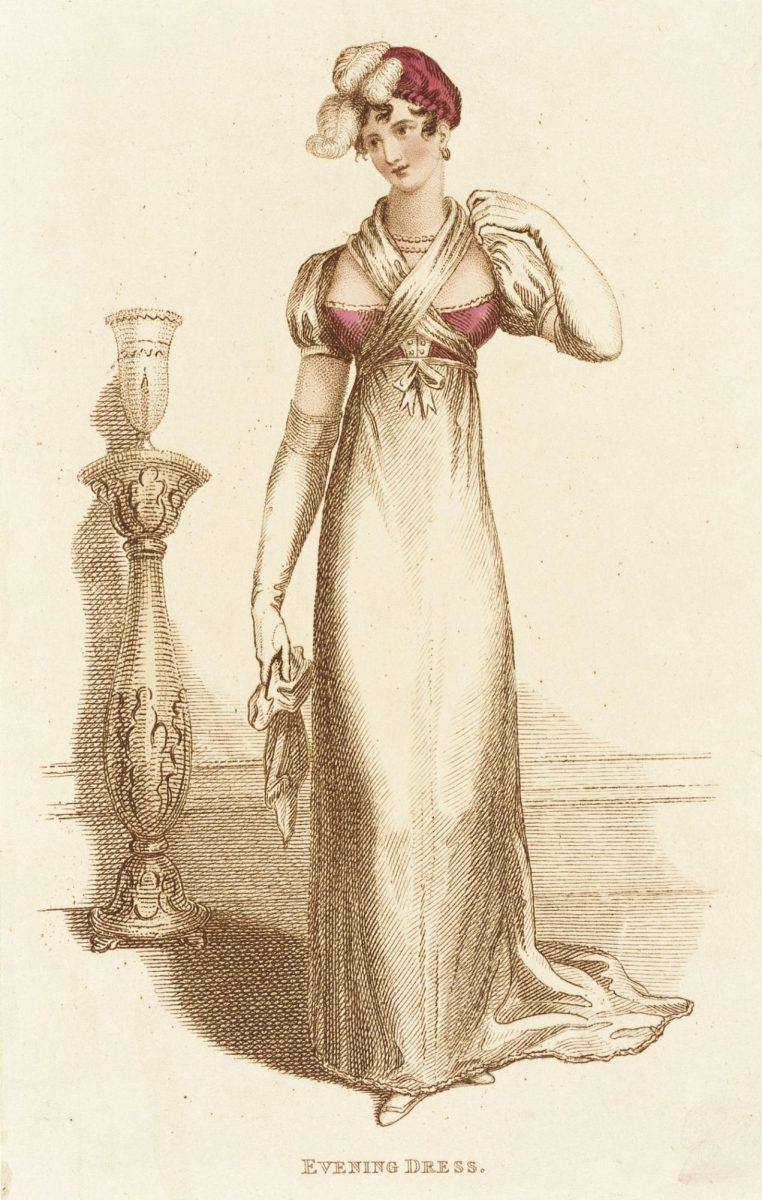In the dazzling world of Bridgerton, where romance and societal affairs intertwine, it’s not just the characters’ words and actions that speak volumes — it’s their attire too. As we eagerly anticipate the release of part two of season three, it’s time to unravel the mysteries behind the stunning fashion choices that have captivated audiences worldwide.
Many people argue that the costumes don’t accurately reflect the Regency Era, which is when the show is set. Critics say that the show went into the future with its designs and with its use of things that weren’t popular during this era such as pearls, glitters, and sequins. However, others believe that this fault doesn’t take away from the story, but adds to it instead.
There have been over 7,500 costumes made for season one alone, and each major character had about 100 each. All the costumes are completely handmade and unique, subtly characterizing the person wearing them. The costume designers of Bridgerton have crafted a visual feast that adds layers of meaning to every stitch and seam.
One of the most intriguing aspects of the show’s fashion is how the colors of the costumes play a pivotal role in character development and storytelling. Most families of the ton (high class society during the Regency era) have a family color palette that members of the same family adorn themselves with.
For instance, the color palette of the Bridgerton family, consisting of lights blues, greens, silvers, and light pinks, reflects their status and importance in society. According to Ellen Mirojnick, the costume designer, these colors are carefully chosen to convey a sense of calm and high societal standards. The Bridgertons’ preference for soft shades speaks volumes about their refined elegance and established position in the social hierarchy. One of the most worn colors of the family is Wedgewood Blue. During that time in history, Wedgewood Blue was a rare color only worn by high-class English families, which serves as a further indication of their status as a wealthy family.
In contrast, the Featheringtons, who are portrayed as outsiders/newcomers in this upper-class society, adorn themselves in vibrant shades of pink, yellow, and green, with distinct flower patterns. These bold color choices not only highlight their struggles, but also serve as a declaration of their presence in a world where they are perceived as outsiders.
Lady Featherington places an emphasis on how the family should always be seen in bold dresses. She makes sure that their outfits stand out not only with their color but with their designs to draw attention and show off their money. However, this doesn’t come off in a positive way; showing off their wealth only calls attention to how they are obviously new money and not used to the high-class society life.
The differences between these two families are obvious when we see scenes between Eloise, the second oldest Bridgerton daughter, and Penelope, the youngest Featherington.
Penelope Featherington is almost always dressed in her signature bright yellow dresses with vibrant floral designs. These dresses, more often than not, are not very flattering on Penelope, as the colors don’t suit her, and make her stand out in all the wrong ways. In contrast, Eloise is always adorned in her family’s light, soft colors.
In season three, viewers can see that Penelope’s wardrobe undergoes a radical change. Abandoning the bright yellow she was almost always adorned with, she instead opts for more softer/vibrant colors like green and, of course, blue. This is, of course, part of the “Bridgerton glow up,” as fans like to call it. The Bridgerton glow up is where a character has a major fashion and a new look when time comes for their season. This happened to Anthony in season two, and it has happened to both Penelope and Colin in season three.
The green Penelope is seen in has more meaning than her “glow up.” Her less-than iconic Featherington yellow and the classic Briderton blue combine to make the bright green color she dresses herself in during the first episode of season three.
Another character that highlights the importance of color in the fashion of this period is the one, the only, Lady Danbury. Lady Danbury, who is often seen dressed in browns and other dark colors in Bridgerton, had a complete outfit change from her younger years, which we see in Queen Charlotte, A Bridgerton Story. In the spinoff, we see that Lady Danbury is often dressed in gold and yellows, mainly because Lord Danbury, her husband, was quite fond of the color. After the death of her husband, we can see the immediate change in her wardrobe, with her instead opting for purples and maroons. This is especially noticeable in the very scene where Lord Danbury passes, as Lady Danbury immediately changes into a purple robe to report his death to her maid.
At the end of Queen Charlotte, however, we can see that Lady Danbury starts wearing several pieces of clothing with gold on them, signaling that she let go of the trauma Lord Danbury gave her and is taking back the color as hers.
Duke Simone Basset of Hastings, who was raised by Lady Danbury, follows her color scheme of dark clothing. His most notable colors are red and gold, which are known to be colors of royalty. He is also seen wearing dark colors, which symbolize his haunting past. These colors also often match the color palette of Lady Danbury, which shows their familial bond.
When Daphne and the Duke get married, Daphne starts wearing more purples, which is a mixture between the Duke’s purple and, of course, the Bridgerton blue.
We see this mix of colors again with season three’s main couple, Colin Bridgerton and Penelope Featherington. Penelope is seen wearing green a lot more in the first part of season three than any other seasons. Although she has adjusted her color palette a few times in the previous seasons, it had always been pinks, save for the one time in season two where she wore green. Green is the color she is seen a lot in part one of season three, and this is because Featherington yellow and Bridgerton blue make, you guessed it, green.
However, it’s not just about the actual colors, but what they symbolize and the details that reveal deeper narratives. Penelope Featherington’s yellow dresses, initially seen as garish, hold a hidden meaning. While yellow symbolizes hope and energy, it also serves as a warning, reminding viewers that not everything that glitters can be trusted — a fitting representation of Penelope’s character, who conceals her true identity as the ton’s infamous gossip columnist under the pen name Lady Whistledown, behind a facade of innocence.
Furthermore, the evolution of the characters’ wardrobes parallels their personal growth and societal dynamics. For example, Daphne Bridgerton’s transition from calming blue to regal purple after her marriage to the Duke of Hastings symbolizes her journey towards independence and the formation of her own family.
In season three, part one, we can also see the fashion style changing, signaling a change in era. Instead of the usual box neckline that Bridgerton dresses usually adorn, we start seeing off-the-shoulder necklines a lot more, along with more sequins and ruffles (which were actually directly stated in the show!). These fashion designs are known to be a part of the Victorian Era, the era after the Regency Era, in which the show is set.

The designs on the dresses also tell great details about characters. Cressida Cowper, a recurring character in the show, is always seen to be in different style outfits than the rest of the young ladies in society. She’s almost always wearing huge sleeves, which costume designer John Glaser said is there to symbolize her as a caged bird. In season three we learn a lot about Miss Cowper and a lot of viewers’ opinions on her change when they actually get to know her. The difference in her dresses compared to all the other ladies also shows her desperation in the marriage mart.
Eloise’s signature dress of the season also hides a very important detail. The dress is glittery and adorned with Geranium pratense flowers, which is a spoiler for what is to come next in her story. Francesca, who is the newest addition to the show, already has her wardrobe filled with hidden spoilers. One of her iconic outfits in the first part of the season features a Scottish tweed mini-sweater and a flower to keep it together. The flower is a camellia, which sometimes has the meaning of love, happiness, and long life. But camellias also have a darker meaning; in Japanese culture, they’re often associated with sudden death, as white camellias don’t lose their petals one by one like most flowers, but lose them all at once. This darker meaning is a foreshadowing for Francesca and her story. The Scottish tweed in the outfit also serves a purpose, as her first husband, the Earl of Kilmartin, is from Scotland.
Queen Charlotte is seen to not adhere to Regency Era clothing and instead opts to stick to the Georgian style all throughout the series. This is allegedly to make sure she is recognizable to her husband, King George, who is on a constant mental decline throughout the series because of his bipolar disorder.
When being presented to the court, the girls of the ton are always featured in white, exemplifying their purity. They also wear feathers, likening them to birds. These girls are caged, with their only purpose of life starting with marriage and ending with childbirth.
Every single outfit in Bridgerton has a hidden meaning one way or another, whether it is to show unity, class, or even to serve as a spoiler. These details are made to deepen our understanding of the characters and their journeys. The careful consideration of color, design, and fabric choices enriches the narrative of the characters, making the costumes not just a visual delight, but also a storytelling tool.
As we anticipate the next part of season three of Bridgerton, let us not overlook the significance of its fashion choices. Behind every shimmering gown and tailored coat lies a story waiting to be told, a story of love, ambition, and the timeless allure of Regency fashion.
It’s not just the characters’ words and actions that speak volumes — it’s their attire, too.

